Social Technology: Why Is it Important?

Social Technology: Why Is it Important?
Social technology might sound like a complicated topic. However, it’s likely that you’re already making use of it at your company. Once you cultivate an understanding of what is and isn’t social technology, you’ll be enabled to better leverage tech processes to meet your marketing needs.
Updated 01/27/2023
Social technology is the result of a digital-first approach to business communications. With the continued rise of digital marketing and the projected growth of the industry in future years, social technology will become an essential asset to most businesses.
Especially with remote and hybrid working environments increasing, social technology is likely to continue to grow both internally and externally to workplaces.
How do you make the most of it? Learn about the specifics of social technology and align your digital marketing strategy to feature its benefits.
What Is Social Technology?
Social technology may sound complicated, but it’s not. Social technology is any technological system that facilitates social interaction or communication between people. In the age of social media, there are plenty of familiar social technologies that people use on a daily basis.
Social technology could include social media platforms, web conferences, blogs, and more. Experts say that social technology can be either software that promotes communication or a communication capability of technology that is specifically tailored to sharing information with others.
Additionally, social technology has been used to describe how people interact with each other in a business setting. Particularly in enterprise settings, companies use enterprise social networking, intranet, collaboration, and more to create a smooth working environment that transitions seamlessly to remote work.
Because of these two distinct types of social technology, businesses can leverage social tech tools for both internal and external uses. Social technologies are tools used to connect people in a digital environment.
Origins of Social Technology
Social technology is an idea that comes from the social sciences and did not always relate to digital technology. In fact, the concept of social technology well predates computers and smartphones.
In the past, the use of social technology was synonymous with using human intelligence and wisdom to affect social processes. This frame of thought is what lead to technology research and technological change.
The original goals of social tech adaption included:
- Technologies of power (ex. laws, symbols, signs)
- Group behavior patterns (ex. Eugenics)
- Individual behavior patterns (ex. legal norms)
- Social interaction technologies (ex. cooperation tech)
- Knowledge development (ex. info aggregation tech)
In this way, the frameworks and methodology of social technology encourage initiatives and new technologies but don’t demand them.
Social Technology vs. Social Engineering
Both refer to social innovation, these terms are incredibly closely related. Social engineering and social technology reference a deliberate design of social organization patterns and norms upon which technology trends are built.
Let’s take crowdsourcing, for example. Every industry, from healthcare to sustainability, can recognize the use and purpose of electronic fundraising. Many organizations in both private and public sectors make use of digital tools like this.
However, the social technology isn’t in the information technology-driven platforms like GoFundMe. It’s in the social norms and expectations surrounding crowdsourcing.
For instance, the human expectation to donate to relevant and important fundraising endeavors shared by loved ones is the social technology that supports crowdsourcing platforms. Human norms and decision making is what keep the new tech afloat.
Benefits of Social Technology
You’ll find that social technology has many of the same benefits of social media. However, from a business perspective, social technology offers additional benefits on an internal level.
From an external customer-facing viewpoint, social technology is meant to connect people with news ideas. The prospect of a quick and engaging avenue of communicating with customers offers a myriad of opportunities for businesses, including the following:
- Promotional space: norms in social technology allows companies to get creative with how they promote themselves with technology for new and existing product campaigns. Social technology captures interest of new audiences, buyers, and stakeholders.
- Easily redirects interested leads: transforming leads into conversions is made easier when tech tools and social technology collide. When people understand the norms and expectations associated with tech, it’s easier to encourage traffic to company websites and make sales.
- Interact with customers: human interaction is a core component of social technology. New technologies (social media, online forums) allow organizations to respond to praise and concerns publicly, encouraging continued innovation.
- Engage and network: beyond connecting with potential buyers, social technology and associated tech platforms make connecting with peers and other organizations simple. This allows for additional collaboration within your own industry.
Social media is an especially great place to connect and interact with prospective clients or customers. For this reason, social technology is a key aspect of most digital marketing strategies.
However, enterprise social software contains aspects of business collaboration tools and social media. This and other types of social technology benefit businesses internally, focusing on clear communication that maintains operational structure.
Business-oriented social technology facilitates collaboration and keeps everyone on the same page. These technologies became particularly popular and essential to success during remote work during the COVID-19 pandemic.
Remote work software allowed coworkers to collaborate without physically working alongside one another. Tons of new remote culture-building companies sprung up, and Zoom became a household name. Social technology made many people’s transition to remote work possible.
Social technology distinctly benefits marketing and corporate management efforts through its ability to bring people together in a virtual setting.
4 Social Technology Examples
Social technology comes in many forms that can be used both inside and outside the walls of your business.
Here are four quick examples of social technology in the world today:
This list only scratches the surface of social technology and its affects on businesses, but it should put into context how prevalent it is in modern society.
1. Artificial Intelligence and Virtual Reality
AI and VR are up-and-coming innovations that are beginning to challenge established social technologies.
Take the Metaverse and ChatGPT, for example. The Metaverse is beginning to interest opportunities who recognize the societal value and interest in gaming, social media, and immersive experiences.
Meta (previously Facebook) now defines itself as a social technology company, and its ability to connect people is exactly the reason why.

Source: Meta
ChatGPT has been an explosive AI innovation that reformulates and eases methods of search queries through an accessible chatbot environment. It was easy for people to find value in ChatGPT as it effectively blended accessibility with innovation.
2. Instagram
When thinking about consumer-facing social technology, social media platforms are the first to come to mind. Especially from a digital marketing perspective, it’s easy to connect with potential leads on platforms such as Instagram.
With roughly one billion active users, Instagram is a popular social technology tool for businesses to connect with target audience groups.

The visuals-first platform encourages engagement and sharing through paid opportunities and stories. Lately, it’s been tailoring its services to suit businesses even more.
By adding a shopping experience as a main product offering, Instagram is now featuring e-commerce businesses and their products. This social technology tool is ideal for those looking to sell products online.
Instagram isn't the only social media platform that uses social technology, however. Other examples include:
- Snapchat
- TikTok
3. Video Conferencing
Video and web conferencing drastically increased in popularity during the COVID-19 pandemic.
Volumes of workers were told to stay home and work remotely until further notice. Many people are still functioning in a remote or hybrid capacity.
Video conferencing allows teammates, friends, or family members to connect via call. However, this social technology tool permits users to hear and see live videos of those they’re calling.

Source: Highfive Video Conferencing
This promotes clear communication, minimizing any text-based miscommunications or opportunities to read between the lines of an email conversation.
In video conferencing settings, social interaction is more direct and replicates an in-person conversation.
4. Slack
Slack and other professional instant messaging platforms gained popularity in recent years because of the fun, light-hearted nature of the platform’s UX and aim to make work relationships more engaging.
The Slack platform specifically appealed to workers and business leaders alike due to its ability to centralize all forms of communication, file sharing, and calls. This blocked out any distractions that might come from bouncing from one platform to another for different communications tasks.

Source: The Verge
Similarly, the platform allows teammates to view or join various channels that provide greater insight into what other teammates are working on.
Slack leveraged key aspects of social technology to promote collaboration within the workplace, regardless of whether it was remote or in person.
Social Technology Connects People
Social technology brings people together in a virtual network of communications, connecting people from all over the world.
This technology presents amazing opportunities for businesses, whether their goal is to tighten internal team communication or to share their work with the world and acquire new leads.
Looking to collaborate with an expert tech team on an upcoming project? Find top software development teams on The Manifest.
